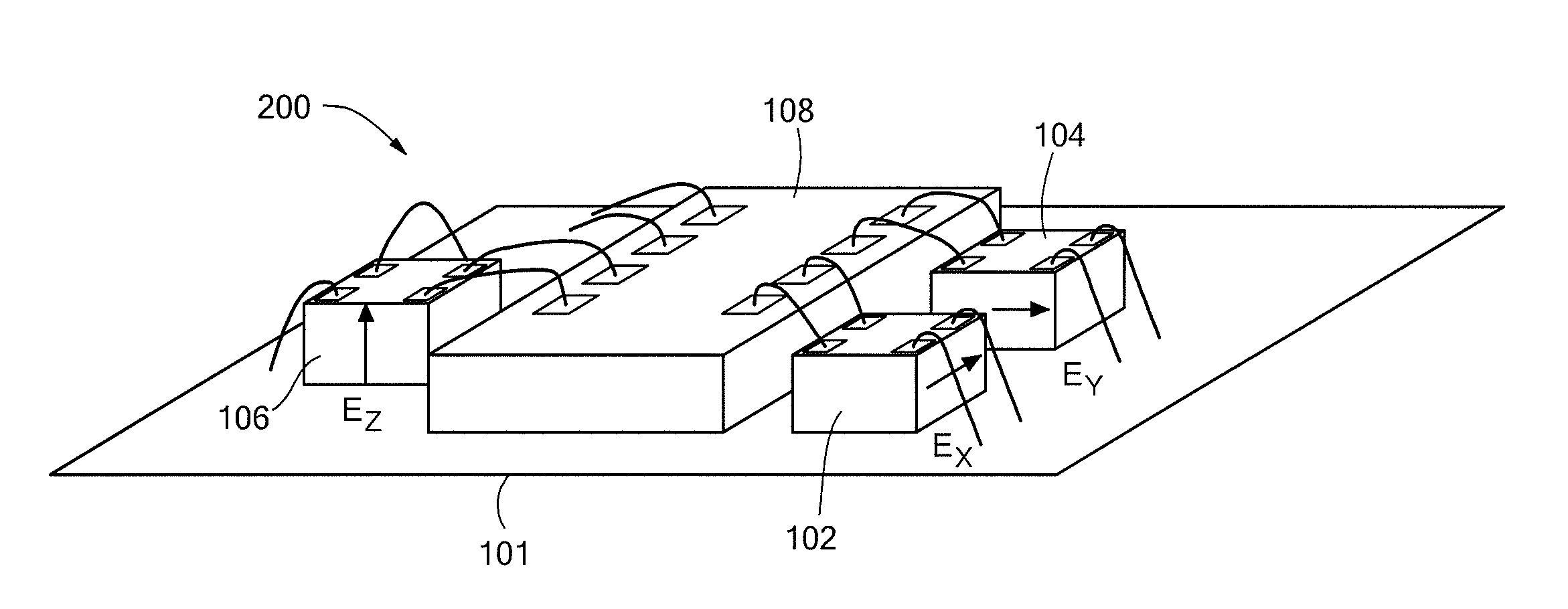Integrated multi-axis hybrid magnetic field sensor
a hybrid magnetic field and sensor technology, applied in the direction of magnetic measurement, instruments, measurement devices, etc., can solve the problems of increasing the cost of manufacturing, increasing the thickness of the final product, and not being well adapted to precisely control the geometry of the inclined plane of the structure, so as to avoid manufacturing complexity, low unit cost, and sufficient sensitivity
- Summary
- Abstract
- Description
- Claims
- Application Information
AI Technical Summary
Benefits of technology
Problems solved by technology
Method used
Image
Examples
third embodiment
[0034]A three-axis magnetic field sensor system according to the present invention is presented in FIGS. 4A and 4B. In this embodiment, a system 400 includes an ASIC 402 having a Hall sensor element 306, integrated in the same way as the ASIC 304 shown in FIG. 3A, mounted on a PCB 403. A two-axis magnetoresistive device 404 that combines two sensor elements, each able to measure a respective component, Ex, Ey, of the magnetic field parallel to the plane made by the PCB 403 and orthogonal to each other, is provided. The magnetoresistive sensor 404 is mounted on top of the ASIC 402, commonly referred to as “stack packaging.”
[0035]Those skilled in the art will notice that such a sensor 404, combining two orthogonal magnetoresistive sensor elements, can be used in other embodiments of the present invention to replace the two magnetoresistive sensors.
[0036]Having a stack configuration, as shown in FIG. 4A, allows a further reduction of the lateral size of the system 400 while also keepin...
fourth embodiment
[0043]A schematic view of a magnetic field sensor system according to the present invention will now be described with respect to FIGS. 6A and 6B. A three-axis system 600 comprises a PCB 602 on which is mounted an ASIC 604. The ASIC 604 includes the electronic circuits for excitation and signal processing of the three sensors elements: a Hall sensor element 306 sensitive to the magnetic axis Ez orthogonal with respect to the plane defined by the PCB 602, and two Hall element switches 606.1, 606.2, able to, respectively, measure the directions of the magnetic field components Ex and Ey parallel to the plane of the PCB 602 and orthogonal to one another. A magnetoresistive sensor 608 is stacked on top of the ASIC 604 using the flip-chip method via solder balls 508. The MR sensor 608 integrates two magnetoresistive sensors that are each sensitive to a magnitude, but not the direction, of the respective component of the magnetic fields Ex, Ey parallel to the plane of the PCB 602 and orth...
PUM
 Login to View More
Login to View More Abstract
Description
Claims
Application Information
 Login to View More
Login to View More - R&D
- Intellectual Property
- Life Sciences
- Materials
- Tech Scout
- Unparalleled Data Quality
- Higher Quality Content
- 60% Fewer Hallucinations
Browse by: Latest US Patents, China's latest patents, Technical Efficacy Thesaurus, Application Domain, Technology Topic, Popular Technical Reports.
© 2025 PatSnap. All rights reserved.Legal|Privacy policy|Modern Slavery Act Transparency Statement|Sitemap|About US| Contact US: help@patsnap.com



